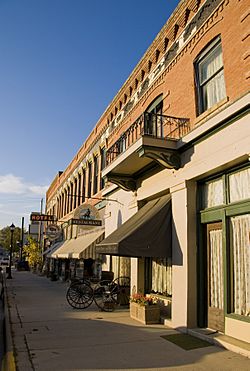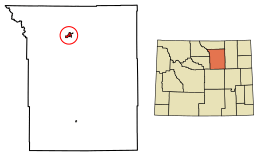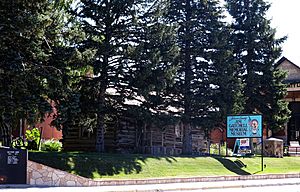Buffalo, Wyoming facts for kids
Quick facts for kids
Buffalo, Wyoming
|
|
|---|---|

Occidental Hotel in Buffalo
|
|

Location of Buffalo in Johnson County, Wyoming
|
|
| Country | United States |
| State | Wyoming |
| County | Johnson |
| Area | |
| • Total | 4.48 sq mi (11.61 km2) |
| • Land | 4.48 sq mi (11.61 km2) |
| • Water | 0.00 sq mi (0.00 km2) |
| Elevation | 4,708 ft (1,435 m) |
| Population
(2020)
|
|
| • Total | 4,415 |
| • Estimate
(2023)
|
4,621 |
| • Density | 1,020.98/sq mi (394.22/km2) |
| Time zone | UTC−7 (Mountain (MST)) |
| • Summer (DST) | UTC−6 (MDT) |
| ZIP codes |
82834, 82840
|
| Area code(s) | 307 |
| FIPS code | 56-10685 |
| GNIS feature ID | 2409934 |
Buffalo is a city in Johnson County, Wyoming, United States. It is also the county seat, which means it's where the county government is located. In 2020, about 4,415 people lived here.
Buffalo's economy relies on energy, farming, tourism, and outdoor activities. The city is at the base of the Bighorn Mountains. It's also located almost halfway between two famous places: Yellowstone National Park and Mount Rushmore.
Contents
Buffalo's Population Over Time
| Historical population | |||
|---|---|---|---|
| Census | Pop. | %± | |
| 1890 | 1,087 | — | |
| 1900 | 710 | −34.7% | |
| 1910 | 1,368 | 92.7% | |
| 1920 | 1,772 | 29.5% | |
| 1930 | 1,749 | −1.3% | |
| 1940 | 2,302 | 31.6% | |
| 1950 | 2,674 | 16.2% | |
| 1960 | 2,907 | 8.7% | |
| 1970 | 3,394 | 16.8% | |
| 1980 | 3,799 | 11.9% | |
| 1990 | 3,302 | −13.1% | |
| 2000 | 3,900 | 18.1% | |
| 2010 | 4,585 | 17.6% | |
| 2020 | 4,415 | −3.7% | |
| 2023 (est.) | 4,621 | 0.8% | |
| U.S. Decennial Census | |||
What the 2010 Census Showed
In 2010, Buffalo had 4,585 people. There were 2,080 households, which are groups of people living together. About 26.8% of these households had children under 18.
The average age in Buffalo was 42.2 years. About 23% of the people were under 18. Another 19.4% were 65 years old or older. The population was almost evenly split between males (50.1%) and females (49.9%).
Geography and Climate of Buffalo
Buffalo covers a total area of about 4.46 square miles (11.6 square kilometers). All of this area is land.
Buffalo's Weather and Climate
Buffalo has a cold semi-arid climate. This means it gets some rain, but not a lot, and it has cold winters.
The hottest temperature ever recorded in Buffalo was 106°F (41°C) on August 5, 1979. The coldest temperature was -40°F (-40°C) on January 17, 1930.
| Climate data for Buffalo, Wyoming, 1991–2020 normals, extremes 1899–2020 | |||||||||||||
|---|---|---|---|---|---|---|---|---|---|---|---|---|---|
| Month | Jan | Feb | Mar | Apr | May | Jun | Jul | Aug | Sep | Oct | Nov | Dec | Year |
| Record high °F (°C) | 71 (22) |
77 (25) |
78 (26) |
88 (31) |
91 (33) |
102 (39) |
105 (41) |
106 (41) |
101 (38) |
91 (33) |
80 (27) |
71 (22) |
106 (41) |
| Mean maximum °F (°C) | 58.8 (14.9) |
57.6 (14.2) |
68.3 (20.2) |
76.0 (24.4) |
83.2 (28.4) |
91.0 (32.8) |
96.4 (35.8) |
94.6 (34.8) |
90.9 (32.7) |
80.6 (27.0) |
67.7 (19.8) |
58.5 (14.7) |
97.3 (36.3) |
| Mean daily maximum °F (°C) | 36.0 (2.2) |
36.5 (2.5) |
46.5 (8.1) |
53.4 (11.9) |
62.4 (16.9) |
73.0 (22.8) |
82.8 (28.2) |
81.8 (27.7) |
71.8 (22.1) |
57.2 (14.0) |
44.9 (7.2) |
36.3 (2.4) |
56.9 (13.8) |
| Daily mean °F (°C) | 23.4 (−4.8) |
24.2 (−4.3) |
33.2 (0.7) |
40.5 (4.7) |
49.7 (9.8) |
59.5 (15.3) |
68.0 (20.0) |
66.3 (19.1) |
56.7 (13.7) |
43.4 (6.3) |
32.1 (0.1) |
23.7 (−4.6) |
43.4 (6.3) |
| Mean daily minimum °F (°C) | 10.7 (−11.8) |
11.9 (−11.2) |
19.9 (−6.7) |
27.6 (−2.4) |
37.0 (2.8) |
45.9 (7.7) |
53.1 (11.7) |
50.8 (10.4) |
41.7 (5.4) |
29.6 (−1.3) |
19.4 (−7.0) |
11.0 (−11.7) |
29.9 (−1.2) |
| Mean minimum °F (°C) | −10.7 (−23.7) |
−6.8 (−21.6) |
3.1 (−16.1) |
15.8 (−9.0) |
26.3 (−3.2) |
36.8 (2.7) |
45.6 (7.6) |
42.6 (5.9) |
29.9 (−1.2) |
14.7 (−9.6) |
1.8 (−16.8) |
−7.8 (−22.1) |
−17.5 (−27.5) |
| Record low °F (°C) | −40 (−40) |
−37 (−38) |
−27 (−33) |
−15 (−26) |
13 (−11) |
27 (−3) |
32 (0) |
30 (−1) |
9 (−13) |
−8 (−22) |
−26 (−32) |
−38 (−39) |
−40 (−40) |
| Average precipitation inches (mm) | 0.44 (11) |
0.53 (13) |
0.72 (18) |
1.49 (38) |
2.80 (71) |
2.16 (55) |
1.39 (35) |
0.75 (19) |
1.28 (33) |
1.25 (32) |
0.51 (13) |
0.43 (11) |
13.75 (349) |
| Average snowfall inches (cm) | 6.6 (17) |
7.4 (19) |
6.5 (17) |
4.2 (11) |
0.9 (2.3) |
0.0 (0.0) |
0.0 (0.0) |
0.0 (0.0) |
0.7 (1.8) |
3.5 (8.9) |
5.9 (15) |
7.0 (18) |
42.7 (110) |
| Average precipitation days (≥ 0.01 in) | 5.4 | 6.7 | 6.4 | 8.4 | 11.7 | 10.0 | 7.6 | 5.9 | 6.0 | 7.1 | 4.7 | 4.8 | 84.7 |
| Average snowy days (≥ 0.1 in) | 4.7 | 6.0 | 3.9 | 2.3 | 0.4 | 0.0 | 0.0 | 0.0 | 0.2 | 1.8 | 3.4 | 4.6 | 27.3 |
| Source 1: NOAA | |||||||||||||
| Source 2: National Weather Service | |||||||||||||
Education in Buffalo
Public schools in Buffalo are part of Johnson County School District Number 1. Students attend:
- Meadowlark Elementary School (Kindergarten to 2nd grade)
- Cloud Peak Elementary School (3rd to 5th grade)
- Clear Creek Middle School (6th to 8th grade)
- Buffalo High School (9th to 12th grade)
Buffalo also has a public library, called the Johnson County Library.
Getting Around Buffalo
Buffalo is located where two major highways meet: Interstate 25 and Interstate 90.
The city has a small airport called the Johnson County Airport (Wyoming). It's for private planes and doesn't have regular passenger flights.
If you need to fly with an airline, here are some nearby airports:
- Sheridan (SHR) - About a 30-minute drive
- Gillette (GCC) - About a 1-hour drive
- Casper (CPR) - About a 1.5-hour drive
- Billings (BIL) - About a 2-hour drive
Public Transportation in Buffalo
Buffalo has a local public transport service called the Buffalo Area Transit System. It's a special service, mainly for seniors, that can take people around Buffalo. It also offers trips to nearby cities like Sheridan and Casper.
You can also find intercity bus services from companies like Express Arrow and Jefferson Lines in Buffalo.
Buffalo's Radio Stations
Here are some of the radio stations you can listen to in Buffalo:
- KBBS AM 1450 - Plays "Classic Country" music.
- KBTG FM 88.3 - Plays "Buffalo's Traditional Gospel" music.
- KBUW FM 90.5 - Part of Wyoming Public Radio.
- KLGT FM 96.5 - Known as "KIX 96.5".
- KZZS FM 98.3 - Known as "The Peak".
Famous People from Buffalo
Some well-known people have connections to Buffalo:
- Mark Gordon (born 1957) - A businessman and rancher from Buffalo, who became the governor of Wyoming.
- Frank E. Lucas (1876–1948) - Also served as a Governor of Wyoming.
- Mathew Pitsch (born 1963) - A politician who is a member of the Arkansas House of Representatives. He was born in Buffalo.
- Chris Prosinski (born 1987) - A professional football player who played for teams like the Chicago Bears.
- Constantine Scollen (1841–1902) - A missionary and priest who lived in Buffalo for a short time.
- Joe Tiller (1942–2017) - A very successful college football coach for the University of Wyoming and Purdue University.
See also
 In Spanish: Búfalo (Wyoming) para niños
In Spanish: Búfalo (Wyoming) para niños



